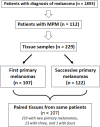Discrepant alterations in main candidate genes among multiple primary melanomas
- PMID: 24885594
- PMCID: PMC4023698
- DOI: 10.1186/1479-5876-12-117
Discrepant alterations in main candidate genes among multiple primary melanomas
Abstract
Background: Alterations in key-regulator genes of disease pathogenesis (BRAF, cKIT, CyclinD1) have been evaluated in patients with multiple primary melanoma (MPM).
Methods: One hundred twelve MPM patients (96 cases with two primary melanomas, 15 with three, and 1 with four) were included into the study. Paired synchronous/asynchronous MPM tissues (N=229) were analyzed for BRAF mutations and cKIT/CyclynD1 gene amplifications.
Results: BRAF mutations were identified in 109/229 (48%) primary melanomas, whereas cKIT and CyclinD1 amplifications were observed in 10/216 (5%) and 29/214 (14%) tumor tissues, respectively. While frequency rates of BRAF mutations were quite identical across the different MPM lesions, a significant increase of cKIT (p<0.001) and CyclinD1 (p=0.002) amplification rates was observed between first and subsequent primary melanomas. Among the 107 patients with paired melanoma samples, 53 (49.5%) presented consistent alteration patterns between first and subsequent primary tumors. About one third (40/122; 32.8%) of subsequent melanomas presented a discrepant pattern of BRAF mutations as compared to incident primary tumors.
Conclusions: The low consistency in somatic mutation patterns among MPM lesions from same patients provides further evidence that melanomagenesis is heterogeneous and different cell types may be involved. This may have implications in clinical practice due to the difficulties in molecularly classifying patients with discrepant primary melanomas.
Figures
References
-
- Dummer R, Hauschild A, Guggenheim M, Keilholz U, Pentheroudakis G. ESMO Guidelines Working Group: Cutaneous melanoma: ESMO Clinical Practice Guidelines for diagnosis, treatment and follow-up. Ann Oncol. 2012;23(Suppl 7):vii86–vii91. - PubMed
Publication types
MeSH terms
Substances
LinkOut - more resources
Full Text Sources
Other Literature Sources
Medical
Research Materials


